Where travel agents earn, learn and save!
Travel & Selling Tips / 10 of the best historic homes to visit in New England
Enjoy an intimate history lesson at these storied homes

In New England, historic houses are two a penny, of course, but these ten homes have stories beyond brick and mortar, or clapboard and shingle.
Orchard House - Concord, Massachusetts

Orchard House in Concord, Massachusetts — Photo courtesy of Linda Laban
This was the house where Louisa May Alcott and her family lived when she wrote "Little Women," creating one of literature’s most endearing and enduring works. Remarkably preserved, this Federal-style clapboard house on the outskirts of still-bucolic Concord still has the very furnishings used by the family, including the simple shelf desk in Louisa’s room where she wrote her most famous novel.
Florence Griswold Museum - Old Lyme, Connecticut

Cafe Flo at the Florence Griswold Museum in Old Lyme, Connecticut — Photo courtesy of Linda Laban
Griswold opened up her coastal Connecticut boarding house to artists, nurturing and encouraging them, and charging small rents. For that, she's often called the patron saint of American Impressionism. At the turn of the 20th century, following the nearby Cos Cob Art Colony, her boarders founded the Old Lyme Colony, which became the largest and best known Impressionist art center in the nation.
Griswold would be happy to see an impressive art museum now stands on the beautiful grounds, and that the paintings the artists added to the interior of her house are still on view. The house, gallery and Cafe Flo are a truly delightful experience.
The Mount - Lenox, Massachusetts

The Mount in Lenox, Massachusetts — Photo courtesy of Linda Laban
Novelist Edith Wharton (“The Age of Innocence”) built her magnificent home in the picture-perfect Berkshires, surrounded by the estates of America’s wealthy Gilded Age elite. The author and her husband maintained the massive house and extensive gardens as their escape from city rigors.
The couple’s beloved dogs are buried on a hillock in the garden, each with an inscribed gravestone. Take a guided tour for the inside story, which reveals the couple did not lead a quiet country life – and their affairs were far from innocent.
Strawbery Banke Museum - Portsmouth, New Hampshire

Strawbery Banke Museum in Portsmouth, New Hampshire — Photo courtesy of Linda Laban
Named Strawbery Banke by the first English settlers, and later called Puddle Dock, this salvaged neighborhood is now an outdoor history museum. Begun in 1958, many of the 32 historic buildings, the earliest dating to 1695, are open to tour; some have exhibits.
Costumed interpreters and informed staff bring to life the stories of families who lived and worked there, including enslaved people and the Abenaki, the Indigenous people who owned this land for thousands of years.
Hildene - Manchester, Vermont

Hildene in Manchester, Vermont — Photo courtesy of Linda Laban
Robert Todd Lincoln, President Abraham Lincoln’s son, and his wife Mary built this Georgian Revival mansion in 1905. Lincoln was the Pullman Company’s president and already aged 62. The non-profit Friends of Hildene took over the property in the 1970s, beautifully restoring the house and formal garden, and turning the carriage barn into a lively gift shop.
The 400-plus acres of natural landscaped grounds houses a restored 1903 Pullman car, called Sunbeam, as well as an agricultural and ecology educational facility that includes Dene Farm, with a solar-powered goat dairy and cheese-making facility and a 600-foot floating wetland boardwalk.
The Crane Estate - Ipswich, Massachusetts

The Crane Estate in Ipswich, Massachusetts — Photo courtesy of Linda Laban
Chicago industrialist Richard T. Crane, Jr., head of a very successful plumbing business (among other things), purchased the land overlooking Ipswich Bay in 1910. It was to be the Crane family’s summer home complete with a grand house that Mr. Crane built twice because Mrs. Crane disliked the first. Finished in 1928, and perched atop Castle Hill, the second house includes lavish Crane plumbing fixtures.
Uniquely, the estate now includes The Inn at Castle Hill, originally Castle Hill Farm, a bed and breakfast at the foot of the hill. The Great House’s undulating half-mile Grand Allée leads from the house to the bluff and passes by the hidden casino complex, where a ballroom and bachelors' quarters were housed.
The best view comes the rooftop terrace, accessed from the third-floor Ship Room – and it does resemble a ship’s cabin. Nearby, Crane Beach is a beautiful pinky-amber sandy expanse not to be missed.
The Breakers - Newport, Rhode Island

The Breakers in Newport, Rhode Island — Photo courtesy of Linda Laban
When Commodore Cornelius Vanderbilt created The Breakers off Newport’s mansion packed Bellevue Avenue, he intended it to be jaw-dropping. Mission accomplished. Even today, its opulence amazes – they didn’t incorrectly call it the Gilded Age – and the views over the bay are magnificent, especially from the second-floor Grecian Revival outdoor terrace.
Now part of the Newport Mansions Preservation Society, a tour ticket gains access to all nine properties, when open, including Chateau-sur-Mer, Chepstow, The Elms, Hunter House, Isaac Bell House, Kingscote, Marble House, Rosecliff, and the fun Green Animals Topiary Garden.
Highfield Hall & Gardens - Falmouth, Massachusetts

Highfield Hall & Gardens, Falmouth, Massachusetts — Photo courtesy of Linda Laban
Built by James Madison Beebe, a Boston-based dry goods merchant and co-founder of the Massachusetts Institute of Technology, Highfield Hall is now a cultural and community center. The main house’s interior is an art gallery, and there are adult and children’s programs. One room on the second floor is dedicated to the tragic history of the Beebe Family, a mighty rise and steep fall.
The gardens are a delight and also include commissioned sculptures and installations. Walk in the 700-acre Beebe Woods, or make some music on the chimes, xylophones and congas in a dell near the main house.
Victoria Mansion - Portland, Maine

Victoria Mansion in Portland, Maine — Photo courtesy of Geoffrey Gross
Built by hotelier Ruggles Sylvester Morse and his wife Olive between 1858 and 1860, the Maine natives used the magnificent house as an escape from oppressive summers in their adopted home of New Orleans. Yet, no expense was spared or luxury excluded. One of the top designers of the day, Gustave Herter, created handsome cabinetry and voluptuous interiors. Victoria Mansion has the only surviving examples of Herter’s work.
Also, almost all of the original trompe l’oeil murals painted by the Italian-born artist Giuseppe Guidicini have survived. The house is a trove of treasures, beautifully cherished.
The Old Manse - Concord, Massachusetts

The Old Manse in Concord, Massachusetts — Photo courtesy of Linda Laban
If any town in New England deserves mention twice for its historic homes, it is Concord, birthplace of two revolutions: firstly, the American Revolution on April 19, 1775, and then in the early 1800s, a revolution in thinking, Transcendentalism, a movement headed by Ralph Waldo Emerson.
The Old Manse belonged to Waldo’s grandfather, Reverend William Emerson, and the family had front row seats to the Battle of Concord by the Old North Bridge, visible through the windows. Emerson eulogized the April 19th battle in his "Concord Hymn," writing about the "shot heard round the world."
He wrote his acclaimed book "Nature" (1836) here, stating “To lose sight of nature is to lose sight of God.” One later tenant, author Nathaniel Hawthorne ("The Scarlett Letter"), describes the 1770 house in "Mosses from an Old Manse" (published in 1846). Not only did he write that book here, but Hawthorne and his wife Sophia etched messages on a window pane that are still visible today.











